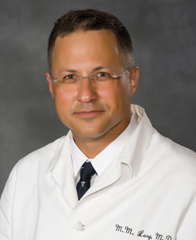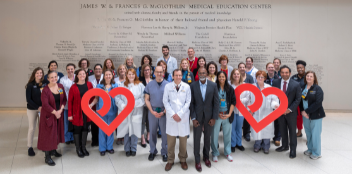Arm Pain? Thoracic Outlet Syndrome …
“It’s an increasing cause of arm pain in athletes and people who work out, as well as those whose work requires them to frequently lift their arms to the shoulder level or above their head,” said Dr. Mark Levy, chair of the Division of Vascular Surgery and the H.M. Lee Professor in Vascular Surgery. “The common clinical scenario is a young patient that presents with shoulder pain, commonly radiating down the arm into the hand, and sometimes into the neck or the back of the head.”
 Dr. Mark Levy
Dr. Mark Levy
The pain results from the compression of the thoracic outlet, the area between the collarbone and the first rib. The compression is usually caused by repetitive motion but may also be caused by whiplash or other trauma. In rare circumstances, a patient may have a bony abnormality called a cervical rib that presses down on the area.
“It’s a relatively narrow space that is usually just big enough to accommodate all these nerves, arteries and veins,” he said. This neurovascular bundle sends sensations to the arms and hands.
Pressure to the area can cause irritation and pain. “If it pinches off the nerve, it causes pain in the shoulder, arm, neck or hand. If it pinches the vein, it can cause a blood clot in the shoulder vein. And, rarely, if it pinches off a subclavian artery, it can cause either blockages or aneurysms in that artery.” Only about 5% of the cases that Levy sees involve the compression of the subclavian arteries, which carry blood from the heart to the arms.
The pain results from the compression of the thoracic outlet, the area between the collarbone and the first rib. The compression is usually caused by repetitive motion but may also be caused by whiplash or other trauma.
Many patients go months without being able to pin down their mysterious ailment. “They have often seen orthopedic surgeons about their shoulder pain and had multiple studies including x-rays and MRIs of the cervical spine, to rule out disk disease,” he said. “They have commonly done months of physical therapy.”
Once thoracic outlet syndrome is suspected, providers often make referrals to Levy, who has over 21 years of experience in the field and is one of very few vascular surgeons in central Virginia to treat the condition.
Levy starts with a patient history and exam. He asks the patient to perform various physical maneuvers that “if positive, are suggestive of thoracic outlet syndrome,” he said. In some instances, an electromyography (EMG) study or other imaging may be helpful.
Patients usually undertake at least one month of highly focused physical therapy. “Much of that involves small but significant postural changes that affect the relationship and spacing between the collarbone and the first rib located below it. If that is effective, and it often can be, then no surgery is required.”
However, if the therapy does not suffice, and the patient’s symptoms are significant and long-lasting, then a minimally invasive surgery known as first rib removal/resection is an option. Sometimes physical therapy is required following the procedure.
“The surgery is most commonly done through a small incision just above the collarbone. Through that incision, we go down about an inch to remove the segment of the first rib that is causing the compression,” said Levy.
The patient undergoes general anesthesia for the operation, which takes just over an hour to do.
“Patients most commonly go home the day after surgery,” he said.
Dr. Levy sees patients at these locations:
• VCU Health at Waterside Commons
• VCU Health Baird Vascular Institute
• VCU Health CMH Surgical Services at C.A.R.E. Building
• VCU Medical Center Ambulatory Care Center
To make an appointment with Dr. Mark Levy, please call (804) 828-7749, press 4.
Back to Spring-2019

